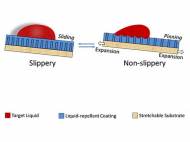Tears-inspired material changes its properties on stimuli
 Inspired by properties of the liquid film that coats the eyes, a team of researchers at the Harvard School of Engineering and Applied Sciences (SEAS) and the Wyss Institute for Biologically Inspired Engineering at Harvard cooperated in order to design a new kind of adaptive material able to change its transparency and wetability features when exposed to external stimuli.
Inspired by properties of the liquid film that coats the eyes, a team of researchers at the Harvard School of Engineering and Applied Sciences (SEAS) and the Wyss Institute for Biologically Inspired Engineering at Harvard cooperated in order to design a new kind of adaptive material able to change its transparency and wetability features when exposed to external stimuli.
Individual tears join up to form a dynamic liquid film with significant optical function that maintains clarity, while keeping the eye moist, protecting it against dust and bacteria, and helping to transport away any wastes – doing all of this and more in literally the blink of an eye.
The material is a next generation of SLIPS (Slippery Liquid-Infused Porous Surfaces) coating we described two years ago, and it is a continuous liquid film that coats, and is infused in, an elastic porous substrate. Any deformation of this substrate, such as stretching, poking, or swelling, changes the size of the pores, causes the liquid surface to change its shape – thus changing transparency and wetability of the material.
When material is undisturbed, droplets of water or oil on its surface flow freely off of the material because it is smooth, clear and flat. When stretched, the material makes the fluid surface rougher, thus changing the opacity of the material and enabling the ability of the material to make every droplet of oil or water that is placed on it reversibly start and stop in their tracks.
According to researchers, this ability to switch between from hydrophobic (water-hating) to hydrophilic (water-loving) states is far superior to the “switchable wettability” of other currently known adaptive materials. They can also design the porous elastic solid in a way that makes it respond to other stimuli, such as change in temperature, light, magnetic or electric fields, chemical signals, pressure, or other environmental conditions.
“In addition to transparency and wettability, we can fine-tune basically anything that would respond to a change in surface topography, such as adhesive or anti-fouling behavior”, said Xi Yao, a postdoctoral fellow at Harvard SEAS and at the Wyss Institute.
The researchers anticipate that the new material could find applications in a diverse range of industries, including oil and gas pipelines, microfluidic and optical systems, building construction, and textiles.
Imagine a tent that blocks light on a dry and sunny day, and becomes transparent and water-repellent on a dim, rainy day. Or highly precise, self-adjusting contact lenses that also clean themselves. Or pipelines that can optimize the rate of flow depending on the volume of fluid coming through them and the environmental conditions outside.
For more information, read the paper published in Nature Materials: “Adaptive fluid-infused porous films with tunable transparency and wettability” [1.3MB PDF].









Leave your response!